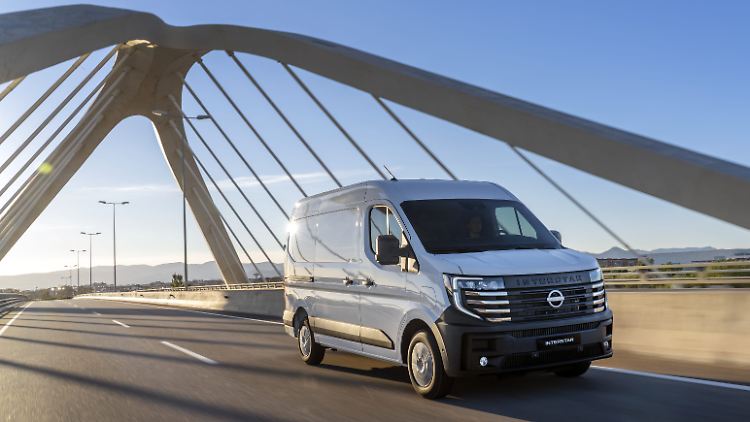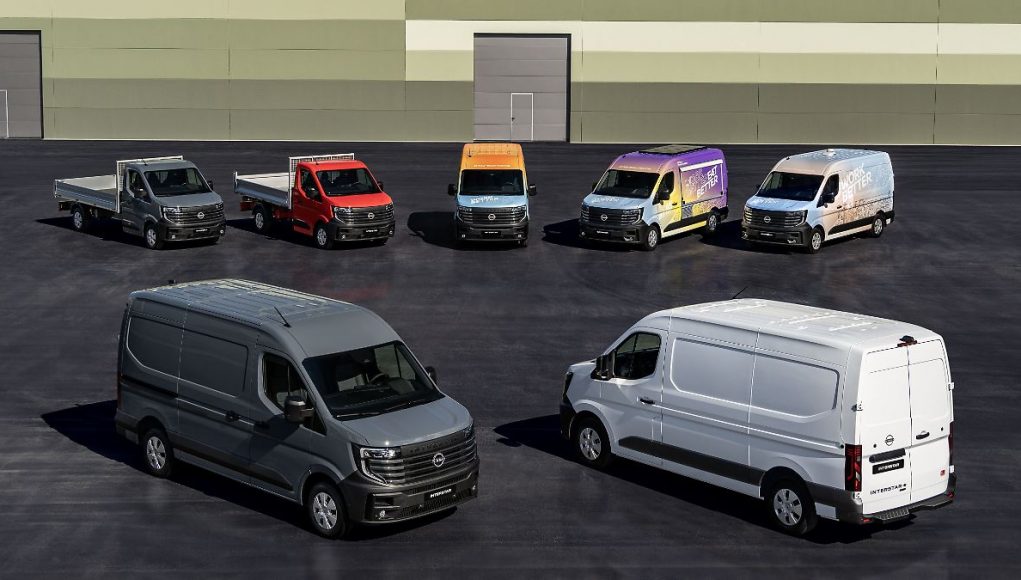Commercial vehicle in the driving report
Nissan Interstar – newly launched transporter under power
This audio version was artificially generated. More info | Send feedback
Something is happening in the class of delivery vans up to 3.5 tons: just a few weeks after the Toyota Proace max, the Japanese competitor Nissan is following suit. The “Interstar” should score points with its practicality, low prices and modern technology. And it's also electric.
The new Nissan Interstar has improved in all respects compared to its predecessors. It has become larger, faster, more variable, more economical and more practical – but also more expensive. Prices (all including VAT) start at 40,750 euros for the short economy version “Acenta” and end – in the diesel version of the drive – at 52,900 euros for the “N-Connection” in the longest and highest version. The electric edition is only available with better equipment for 63,500 euros.


The basis is again the Renault Master.
(Photo: Nissan)
The next generation will be produced as usual in Batilly near Metz, France; The similarity to the Renault Master is not a coincidence, the two vehicles are identical.
The two-liter four-cylinder diesel that is used in the new Interstar is an old friend. It goes by the name M 920, was and is used in numerous Nissan models and is available to the Interstar in four performance levels with 105, 130, 150 or 170 hp. WLTP consumption has been reduced by around 1.5 liters/100 kilometers compared to its predecessor and is now between 7.4 and 8.5 liters/100 kilometers.
The maximum torque in the highest performance level is 380 Newton meters, with the most powerful engine the Interstar can travel at speeds of up to 177 km/h. Either a six-speed manual transmission or a nine-speed automatic transmission is flanged. The front wheels are driven. This also applies to the 105 kW/143 hp electric motor, which initially comes with an 87 kWh battery.
Smaller battery coming in 2025
Nissan has announced a smaller, city-friendly battery with 40 kWh for next year. The Interstar-e takes 130 kW on the fast charger and charges electricity for up to 252 kilometers in 30 minutes. The usual 22 kW flows at the normal charging station. It takes just under four hours to charge the battery from 10 to 100 percent. An 11 kW onboard charger will follow soon. According to Nissan, the maximum range is 460 kilometers.


The van has increased in capacity.
(Photo: Nissan)
While the electric Interstar can only be ordered in the small L2H2 edition, the diesel variants are available in two lengths and two heights – L2H2 and L3H3 – as a panel van and even as a solo chassis for individual construction and expansion. The boxes have significantly increased in capacity. In the L2H2 version, the cargo space has a volume of 10.8 (L3H3: 14.8) cubic meters, the maximum cargo space length is 3.85 meters.
A lid for each pot
The payload of the four-ton diesel variant is up to 1,925 kilograms. As a chassis, the maximum payload for the diesel is up to 2175 kilograms and for the fully electric version it is up to 1925 kilograms. The maximum trailer load is 2.5 tons, with the electric drive it is 2.0 tons. The electric one can move a payload of 1.5 tons.


Various industry variants are also available.
(Photo: Nissan)
Like the competition, the Interstar shines with an almost unmanageable variety of body combinations. Every potty should find its lid here. There are also tipper trucks and bare chassis for mobile home construction in the starting blocks.
Normal vehicle key and more analogues
At the driver's seat, the new Interstar now has the usual amenities that make the commercial vehicle at least a little bit like a car. The cockpit is exceptionally driver-focused for a van, well tidy and complete. The contemporary connectivity is available on a not-too-large central display, and the “classic” instrument behind the steering wheel provides all the necessary information.


The cockpit of the Nissan Interstar is simple but modern and functional.
(Photo: Nissan)
Despite all its modernity, Nissan does not shy away from analogue features: Even the Interstar-e is woken up with an ordinary vehicle key that has to be turned in a lock on the steering column and the handbrake works mechanically – including a rattling noise.
Very lively impression
On the move, the electric Interstar leaves a very lively impression. Despite 400 kilograms of ballast in the cargo area, it pulls well even on steep hills; the top speed is limited to 120 km/h. The steering and chassis work reliably, the developers came up with something special for the brakes and combined all the control systems in a control module called “Onebox” – with a convincing effect.


For the first time, an electric model is also available.
(Photo: Nissan)
The new Interstar is essentially intended to find its customers where its predecessor did: with small businesses, in the transport industry and with people who want to make their own living in a small commercial vehicle. At the presentation, Nissan showed a panel van as a food truck, a flatbed vehicle as a moving helper and, in the electric version, a “Nordic edition” with a functioning sauna.
Nissan Interstar-e – technical data
- Commercial vehicle panel van up to 3.5 tons, length: 5.68 meters, width: 2.46 meters (with mirror); Height: 2.49 meters; Wheelbase: 3.58 meters; side sliding door: passage 1.31 meters; Driver's cab with two seats; Load space volume: 10.8 cubic meters;
- Electric motor with 143 HP/105 kW; continuously variable automatic; maximum torque: 300 Nm; Vmax: 120km/h; Standard consumption: kA; Battery capacity (Li-Io): 87 kWh; Range (WLTP): 400 kilometers; Fast charger charging power (DC): 130 kW, standard (AC): 22 kW, charging time 10 to 100 percent: 3.9 hours.
Brief characteristics
- Why: Relatively cheap price, chic ambience for a commercial vehicle
- Why not: For now only one version in terms of drive and structure
- Who else: Renault Master, Stellantis transporter e.g. Toyota Proace max































